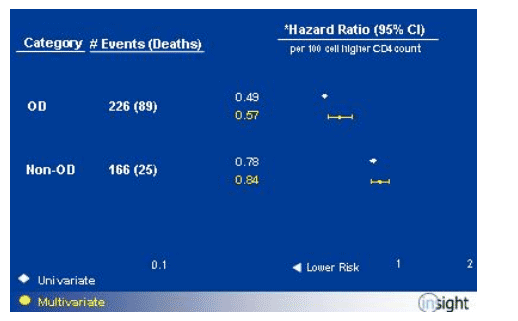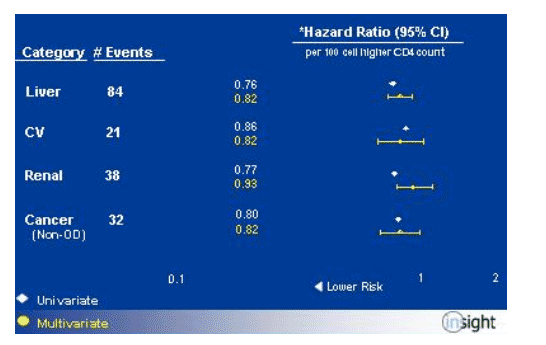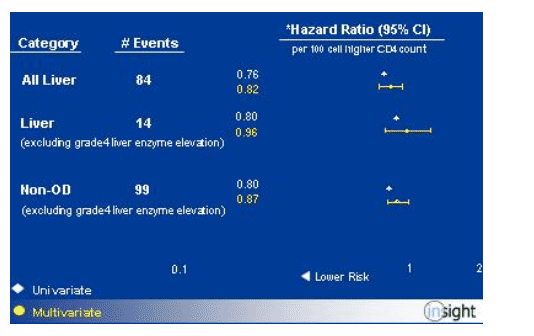 |
 |
 |
| |
Higher CD4 Count Prevents End-Organ Diseases
|
| |
| |
Reported by Jules Levin
CROI, Feb 25-28, 2007, Los Angeles
"HIV-Related Immune Suppression After ART Predicts Risk of Non-Opportunistic Diseases: Results from the FIRST Study"
Jason Baker (Univ of Minnesota at Minneapolis) presented results for Grace Peng, Josh Rapkin, Donald Abrams, Michael Silverberg, Winston Cavert, Rodger MacArthur, Keith Henry, and James Neaton for the CPCRA.
... Rates of end-organ diseases or non-OD decrease at higher CD4 counts during treated HIV-infection.....risk decreases with every 100 CD4 cell increase.... Risk for a liver event decreased by 18% per 100 cell higher CD4 count; risk for a cardiovascular event decreased by 18% per 100 cell higher CD4 count; risk for a renal event decreased by 7% per 100 cell higher CD4 count; risk for non-OD cancer decreased by 18% per 100 cell higher CD4 count.....
Background
Combination ART for HIV drastically has led to marked reductions in morbidity and mortality. Improved survival has been driven primarily by reductions intraditional opportunistic infections (OD). In fact, common end-organ diseases are now more common among HIV-infected individuals. In the SMART study published last year in NEJM, both severe non-fatal and fatal non-opportunistic disease (non-OD) diseases were more common with episodic use of ART (interruptions), and some of the risk for these events may be due to the lower CD4 and higher HIV RNA in the interruption arm. Further, in the DAD cohort, mortality rates from liver disease as well as non-ODs combined have been associated with lower CD4 counts. To date, most studies have focused on mortality from non-ODs as opposed composite outcomes that include both fatal & severe nonfatal events. He said "most of us have presumed that prolonged survival & increasing age explained most of this increase in end-organ disease", but NOT ME (Jules) nor anyone else following these developments closely.
This study asks, among HIV+ patients on ART, do lower CD4 levels contribute to risk of fatal, and non-fatal, diseases not traditionally considered opportunistic ('non-OD').
The FIRST Study randomized 1397 patients to PI strategy, NNRTI strategy, or 3-class strategy. Average age was 38, women 21%, non-whites 74%. Median followup was 5 years. Multivariate analysis adjusted for latest HIV RNA and baseline covariates: age, gender, race, IDU, prior AIDS, hepatitis B/C. Hazard ratios (HR) estimated from Cox models describe OD/Non-OD event associations with time updated ('latest') CD4 count (pooled across treatment strategy).
Outcomes of interest: fatal & non-fatal clinical events
OD= opportunistic diseases
Non-OD = Non-opportunistic Diseases
--Liver=cirrhosis, grade 4 elevated liver enzymes (>10xULN), death from liver failure)
--CV (cardiovascular)= myocardial infarction, stroke, coronary intervention, death fromn chronic ASCVD
--Renal= renal insufficiency, end-stage renal disease, death from chronic kodney disease
--Cancer (non-OD) = all cancers excluding KS, lymphoma and invasive cervical cancer.
For the FIRST cohort baseline CD4 count was median 183 & HIV RNA 5.2 log with 0% <50 c/ml. At month 32 median CD4 count was 399, median VL <1.7 log, and 55% below 50 c/ml. For patients with ODs (n=226) the latest median CD4 was 63, VL 4.9 log, and 16% <50 c/ml. For patients with non-ODs the latest median CD4 was 239, VL 3.1 log, and 30% had <50 c/ml.
Event Rate by Latest CD4
As CD4 counts increase from 200 to >500 patients are more at risk for non-OD events than ODs. In other words increases in CD4 counts protect patients more against ODs than non-ODs although increasing CD4 counts protect patients from both. When CD4 counts are below 200 patients are at much greater risk for ODs, but this is obvious.

Event Risk Predicted by Latest CD4
This graph shows the risk of an OD or non-OD event per every 100 higher CD4 cell count. Lower risk is associated with a higher CD4 count. By multivariate analysis there is a 43% decreased risk of OD and a 16% reduced risk of a non-OD per every 100 CD4 cell higher count. A hazard ratio of 1 represents no association between CD4 count and events.

'Non-OD' Event risk Predicted by Latest CD4 (multivariate analysis)
Risk for a liver event decreased by 18% per 100 cell higher CD4 count (HR 0.76); risk for a cardiovascular event decreased by 18% per 100 cell higher CD4 count (HR 0.82); risk for a renal event decreased by 7% per 100 cell higher CD4 count (HR 0.93); risk for non-OD cancer decreased by 18% per 100 cell higher CD4 count. Some of the confidence bounds cross one.

Liver Related Event Risk
They looked more closely at all liver events since a disproportionate amount of these events were due to grade 4 elevations in liver enzymes most of which occurred during the first year after starting ART. As a result they excluded grade 4 liver enzyme elevations and reran associations of with latest CD4 count and liver events and a composite of non-OD. The confidence bounds overall become much wider with association with liver events given the low number of cirrhosis outcomes in FIRST overall but despite this the adjusted estimates for non-OD composite with latest CD4 still remain significant.

In the Q&A although it was difficult to hear because the microphone wasn't it sounded like the question was what cancers were most common, and the response was skin, lung, and anal cancer represented about 5 cancers each out of a total of 35.
Limitations of the study include the low numbers of events overall and therefore inadequate power to reliably estimate associations between latest CD4 and the specific end-organ diseases that made up our composites of liver, cardiovascular, renal and non-OD cancers. Also, the FIRST cohort is one with advanced disease or low CD4 at initiation of therapy, which limits ability to assess risk at higher CD4s specifically above 350.
The author summarized:
Rates of end-organ diseases or non-OD decrease at higher CD4 counts during treated HIV-infection, though less than for traditional OD.
Liver, CV, renal and cancer events account for more morbidity and mortality than OD events at CD4 counts >200.
This association between latest CD4 count & risk of these events seems to persist after adjusting for additional risk factors. So, even though the reduction of non-OD events at higher CD4 counts was small in this analysis this degree of risk reduction could be important if applied to the greater population oh HIV-infected individuals.
|
| |
|
 |
 |
|
|